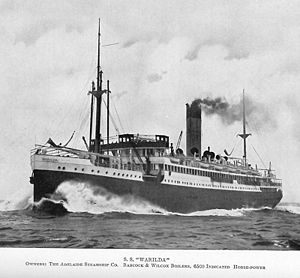 | |
| History | |
|---|---|
| Name | Warilda |
| Operator | |
| Builder | William Beardmore and Company, Glasgow |
| Yard number | 505 |
| Launched | 5 December 1911 |
| Maiden voyage | 1912 |
| Fate | Torpedoed by German U-boat UC-49 on 3 August 1918. [1] |
| General characteristics | |
| Tonnage | 7713 tons gross |
| Length | 411 feet 3 inches (125.35 m) |
| Beam | 56 feet 7 inches (17.25 m) |
| Draught | 34 feet 1 inch (10.39 m) |
| Installed power | 626 nhp on 6 coal-fired boilers |
| Propulsion | Twin quadruple expansion engines |
| Speed |
|
HMAT Warilda (His Majesty's Australian Transport) was a 7713-ton vessel, built by William Beardmore and Company in Glasgow as the SS Warilda for the Adelaide Steamship Company. [2] She was designed for the East-West Australian coastal service, but following the start of the First World War, she was converted into a troopship and later, in 1916, she was converted into a hospital ship.
Contents
Her identical sister ships, also built by William Beardmore and Company, were SS Wandilla (1912) and SS Willochra (1913).[ citation needed ]

